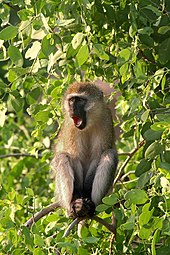Chlorocebus
[2] Unlike the closely related guenons, Chlorocebus species are not primarily forest dwellers.Rather, they are semi-arboreal and semi-terrestrial, spending most of the day on the ground feeding and then sleeping at night in the trees.[2] These monkeys are territorial animals, and a group can occupy an area of approximately .06 to 1.78 km2 (0.023 to 0.687 sq mi).[2] On the island of Saint Kitts, they will commonly steal brightly coloured alcoholic drinks left behind by tourists on the beach.Generally, the male will display a striking, light-blue scrotal pouch, most prevalent during the mating season.On the island of Barbados, farmers complain about the monkeys damaging their crops, and many try to find ways to keep them at bay.[21][22][23][24] In some African countries, many monkeys are killed by power lines, dogs, predatory animals e.g. wild cats, vehicles, shooting, poisoning, and hunting for sport.Added to this, an increase in desertification, and loss of habitat due to agriculture and urbanisation has occurred.[citation needed] The African green monkey has been the focus of much scientific research since the 1950s, and cell lines derived from its tissues are still used today to produce vaccines for polio[25] and smallpox.[33] Chlorocebus monkeys are an important model organism for studies of AIDS, microbiome, development, neurobehavior, neurodegeneration, metabolism and obesity.It facilitated genomic investigations in this monkey, including population genetics studies across Africa and Caribbean[36] and characterization of gene expression regulation across development in brain and peripheral tissues,[37] during prenatal development,[38] and during reaction to psychosocial stress related to relocation and social isolation.

green monkeygrivetmalbrouckvervetScientific classificationEukaryotaAnimaliaChordataMammaliaPrimatesHaplorhiniSimiiformesCercopithecidaeCercopithecinaeCercopitheciniJ. E. GrayType speciesSimia aethiopsLinnaeusChlorocebus aethiopsChlorocebus cynosurosChlorocebus djamdjamensisChlorocebus dryasChlorocebus pygerythrusChlorocebus sabaeusChlorocebus tantalusOld World monkeysspeciessubspeciesmonkeyssub-Saharan AfricaSenegalEthiopiaSouth AfricaAtlantic OceanCaribbeanWest IndianBarbadosSaint KittsAnguillaSaint MartinBroward County, FloridaguenonCercopithecus aethiopsBale Mountains vervetNeumann VU Dryas monkeySchwarz EN LC ScopoliTantalus monkeyOgilbyVervet monkeyF. CuvierCercopithecusdorsalscrotumsexually dimorphicguenonsarborealterrestrialdiurnalmultiple male/multiple femalephilopatrySamburu National Reservechimpanzeesbaboonsomnivorousblackoutdesertificationvaccinessmallpoxhigh blood pressuresimian immunodeficiency virushuman immunodeficiency virusVero cellscell lineepithelialkidneyimmunologyinfectious diseaseWayback MachineEpigenetic clockIUCN Red List of Threatened SpeciesAnimal Diversity WebUniversity of MichiganYouTubeTurner, TrudyTurner, Trudy R.BibcodeA & C BlackBloomsbury PublishingWikispeciesCercopithecidae (Old World monkeys)AllenopithecusAllen's swamp monkey (A. nigroviridis)MiopithecusAngolan talapoin (M. talapoin)Gabon talapoin (M. ogouensis)ErythrocebusSouthern patas monkey (E. baumstarki)Common patas monkey (E. patas)Blue Nile patas monkey (E. poliophaeus)Dryas monkey (C. dryas)Green monkey (C. sabaeus)Grivet (C. aethiops)Bale Mountains vervet (C. djamdjamensis)Tantalus monkey (C. tantalus)Vervet monkey (C. pygerythrus)Malbrouck (C. cynosuros)AllochrocebusL'Hoest's monkey (A. lhoesti)Preuss's monkey (A. preussi)Sun-tailed monkey (A. solatus)Diana monkey (C. diana)Roloway monkey (C. roloway)Greater spot-nosed monkey (C. nictitans)Blue monkey (C. mitis)Mona monkey (C. mona)Campbell's mona monkey (C. campbelli)Lowe's mona monkey (C. lowei)Crested mona monkey (C. pogonias)Wolf's mona monkey (C. wolfi)Dent's mona monkey (C. denti)